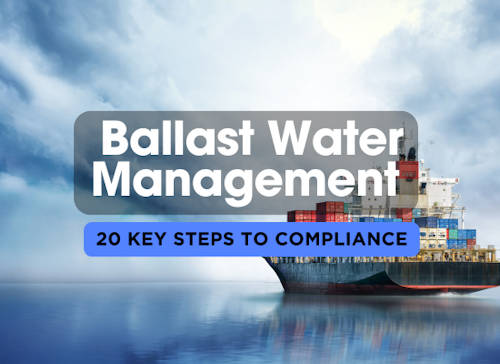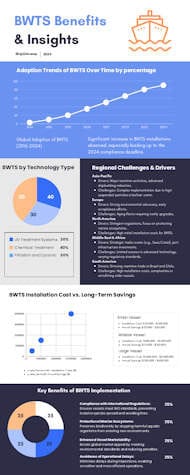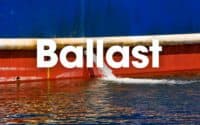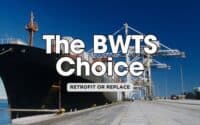20 Key Steps to Compliance with Ballast Water Management Regulations

Effective ballast water management is crucial for protecting marine ecosystems and ensuring compliance with international regulations. For shipowners, adhering to the Ballast Water Management Convention (BWMC) and other related regulations is not just about avoiding fines—it's about maintaining the operational integrity of their vessels and contributing to global environmental sustainability. This comprehensive guide outlines the 20 key steps that shipowners must follow to achieve and maintain compliance with ballast water management regulations. From understanding the legal framework to selecting the right treatment systems and training your crew, these steps will help ensure that your vessel remains compliant and operates efficiently in today's increasingly regulated maritime environment.
Check it out
This ShipUniverse infographic dives into the essential benefits of Ballast Water Treatment Systems. From compliance to ecosystem protection, see how BWTS is transforming maritime operations for the better!
| ShipUniverse: 20 Key Steps to Compliance with Ballast Water Management Regulations | ||
|---|---|---|
| Step | Details | Compliance Impact |
| 1. Understand the IMO Ballast Water Management Convention (BWMC) | Familiarize yourself with the IMO’s Ballast Water Management Convention, including its requirements, timelines, and enforcement mechanisms. Ensure your team understands the global regulatory framework that governs ballast water management. | High - Fundamental to all compliance efforts. |
| 2. Conduct a Vessel-Specific Risk Assessment | Perform a risk assessment for each vessel in your fleet to identify specific challenges related to ballast water management. Consider factors such as operating regions, vessel type, and existing equipment. | High - Tailors compliance strategies to individual vessels. |
| 3. Develop a Ballast Water Management Plan (BWMP) | Draft a comprehensive Ballast Water Management Plan that outlines procedures for managing ballast water on board. Ensure the plan is vessel-specific and complies with both international and local regulations. | High - A core requirement under the BWMC. |
| 4. Select an Approved Ballast Water Treatment System (BWTS) | Choose a ballast water treatment system that is approved by the IMO and compatible with your vessel's operational profile. Consider factors such as treatment efficacy, operational costs, and integration with existing systems. | High - Essential for meeting treatment standards. |
| 5. Install the Ballast Water Treatment System | Ensure proper installation of the chosen BWTS by qualified professionals. Verify that the system is integrated seamlessly with your vessel’s existing operations and that it meets all regulatory requirements. | High - Critical for operational compliance. |
| 6. Train Crew Members on BWTS Operation | Provide comprehensive training for your crew on the operation, maintenance, and troubleshooting of the BWTS. Regular training updates should be scheduled to accommodate new regulations or system upgrades. | Medium - Ensures proper system usage and compliance. |
| 7. Implement Routine System Maintenance | Establish a regular maintenance schedule for the BWTS to ensure optimal performance. Include checks on filters, UV lamps, chemical dosing systems, and other key components. | Medium - Prevents system failure and non-compliance. |
| 8. Conduct Regular Ballast Water Sampling | Perform regular sampling and testing of ballast water to verify that it meets discharge standards. Use accredited laboratories to analyze samples and document the results as part of your compliance records. | High - Verifies ongoing compliance with discharge standards. |
| 9. Maintain Detailed Records | Keep thorough records of all ballast water operations, including uptake, treatment, and discharge. Ensure that logs are complete, accurate, and available for inspection by regulatory authorities. | High - Essential for demonstrating compliance during inspections. |
| 10. Conduct Internal Compliance Audits | Schedule regular internal audits to assess compliance with ballast water management practices. Identify any gaps or deficiencies in your procedures and take corrective actions as needed. | Medium - Ensures continuous improvement and adherence to regulations. |
| 11. Stay Updated on Regulatory Changes | Monitor changes in international and local ballast water regulations. Adapt your management plan and operational practices to reflect new requirements and ensure ongoing compliance. | High - Critical for maintaining compliance over time. |
| 12. Engage with Classification Societies | Work closely with your classification society to ensure your vessel’s ballast water management practices meet all relevant standards. Obtain necessary certifications and documentation to verify compliance. | Medium - Facilitates smooth inspections and certifications. |
| 13. Prepare for Port State Control (PSC) Inspections | Ensure your vessel is ready for Port State Control inspections by keeping all ballast water management documentation, system certificates, and records up to date and easily accessible. | High - Reduces the risk of detentions or fines during inspections. |
| 14. Optimize Ballast Water Exchange Procedures | Where applicable, ensure that ballast water exchange procedures are conducted in compliance with regulations. Document all exchanges and verify that they are performed in designated areas. | Medium - Necessary where treatment systems are not installed. |
| 15. Address Non-Compliance Promptly | If non-compliance is detected, take immediate corrective action. Report any incidents to the relevant authorities and document the steps taken to resolve the issue. | High - Mitigates legal and financial risks. |
| 16. Integrate Ballast Water Management with Environmental Policies | Align your ballast water management practices with broader environmental and sustainability policies. This integration can enhance overall compliance and reduce environmental impact. | Medium - Supports corporate sustainability goals. |
| 17. Utilize Remote Monitoring and Reporting | Consider implementing remote monitoring systems to track ballast water treatment operations in real-time. These systems can improve compliance by providing instant data and alerts. | Medium - Enhances operational oversight and compliance. |
| 18. Review and Update the BWMP Regularly | Periodically review and update your Ballast Water Management Plan to reflect any changes in operations, regulations, or technologies. Ensure the plan remains relevant and effective. | Medium - Ensures the BWMP remains aligned with current practices and regulations. |
| 19. Collaborate with Industry Peers | Engage with industry peers to share best practices and learn from their experiences with ballast water management. Collaboration can lead to innovative solutions and improved compliance strategies. | Low - Valuable for continuous learning and improvement. |
| 20. Plan for System Upgrades | As technology evolves, plan for future upgrades to your BWTS to maintain compliance and enhance efficiency. Consider the lifecycle of your current system and budget for replacements or enhancements. | Medium - Future-proofs your vessel against upcoming regulatory changes. |

Do you have a Maritime Product or Service that may be of interest to Shipowners? Tell us about it here!
Do you have feedback or insights? Please reach out to editor @ shipuniverse.com



